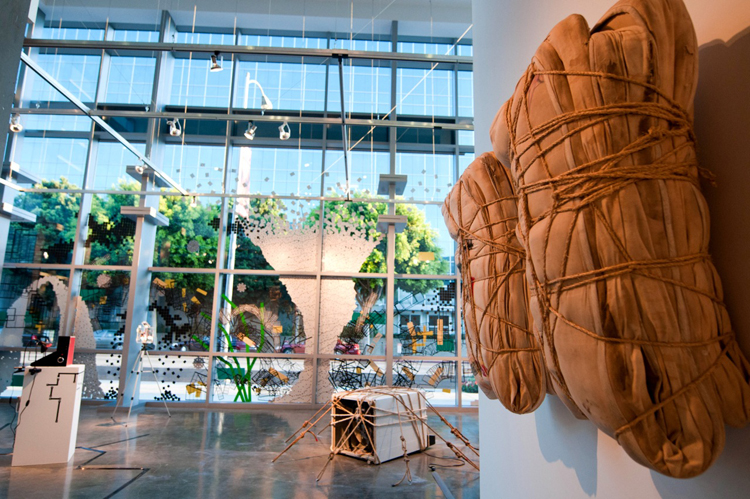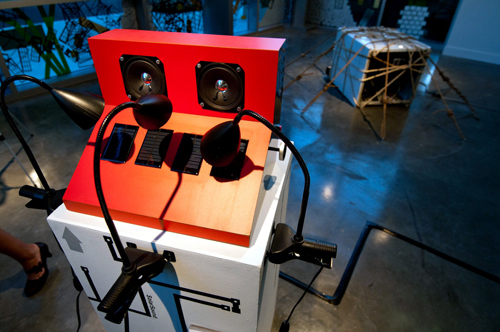The Museum of Latin American Art in Long Beach calls itself, “The only museum in the United States exclusively dedicated to modern and contemporary Latin American art.” Yet its permanent collection is comprised largely of works from Mexico, with exhibitions often featuring art from that country. Idurre Alonso, curator there since 2002, talks about the “aestheticism” of contemporary Mexican art that is on a par with that from the United States and Europe. She credits this in part to Mexico’s comprehensive support of the arts. “The country gives out so many grants that emerging artists are able to live largely on grant money.” She adds that the government supports most museums, freeing them to devote energy to exhibitions, while Mexican citizens are usually admitted for free. “On weekends, museums and galleries are filled with families of all classes,” she says, adding, “Art there is not just for the elite.” Mexico’s support for the arts goes back 100 years to when the government subsidized its murals, regarding them as tools for education about the country’s history.
Alonso grew up in the Basque country of Spain with art-loving parents and grandparents. As a child, she frequented the local Bilbao museum and later the Guggenheim Museum there. While in college, she interned at MOLAA, developing a passion for Latin American art, and began working there after graduation. Since starting there, Alonso and the staff have been working toward connecting Latin American art with that of disparate locales, creating exhibitions with a more universal approach.
Alonso curated “Descartes” in 2010, showing work by Mexican artists who emerged into the Tijuana-based international art scene in the late 1990s. The Collaborative Gallery (jointly owned by MOLAA and Long Beach) exhibition featured “readymade” objects, exploring Mexican-related issues such as immigration, exploitation, consumerism and the environment. UCLA graduate Camilo Ontiveros’ Deportables/Mattresses, constructed from discarded mattresses, bound in rope and hung on the wall, and his Restrained (both, 2008), a beat-up washing machine on its side, depict the selling of cast-off objects in Mexico at outrageous prices. Solar Garden (2010) by Dream Addictive (the art collective, Leslie García and Carmen González) employs recycled electronic and solar-powered equipment, demonstrating that even solar material is discarded in our throwaway world. Jaime Ruiz-Otis’ Untitled (2010) is a landscape made from discarded industrial stickers and labels.
At our meeting, Alonso pulls out three MOLAA exhibition catalogs, providing historical reference for contemporary Mexican art. “Mex/L.A. ‘Mexican’ Modernism(s) in Los Angeles, 1930–1985” explored the relationship between artists and supporters on both sides of the border. The show included descriptions of Los Angeles murals by José Clemente Orozco and David Alfaro Siqueiros and graffiti art by Chaz Bojorquez. There was also Disney animation inspired by Mexican culture, including The Three Caballeros (1945) starring Donald Duck. Pieces in this show, largely from the “Mexican modernism” era, often incorporate influences from primitive and unschooled artists—a trend persisting in Mexican art today.
The museum’s 2011 “Mexico: Expected/Unexpected,” with modern and contemporary paintings, photography, installation, video art and sculpture from Latin America, Europe and the United States, included works by Mexicans Carlos Amorales and Manuel Álvarez Bravo, and by Americans Ana Mendieta (born in Cuba) and contemporary artist Ed Ruscha. Amorales’ Panorama (2007), large collage drawings with stark images of birds, apes, humans and hybrids depicts violence in humans and animals. These were hung near Mendieta’s equally dark On Giving Life (1975), a photograph of the artist lying naked in the grass atop a skeleton.
“Changing the Focus: Latin American Photography 1990–2005” (2010), curated by Alonso, demonstrated how “Latin American photography took its rightful place within the international contemporary art scene,” as the catalog explains. It explored current social, political and economic perspectives of Latin American photographic art. Death by Tupperware (2005) by Daniela Edburg from Mexico, of a woman in her kitchen being strangled by a monster arising from a plastic container surrounded by American convenience foods, is a metaphor for the perceived strangulation of Mexico by the U.S. and its processed products. Two elegant images by Mexican Daniela Rossell, from her 2002 “Rich and Famous” series, portray wealthy Mexican women in palatial estates, both homes lavishly appointed with Latin and European décor. These photos, referencing iconic Renaissance paintings, provide a window into this (nearly oligarchic) country’s embrace of styles and cultures far beyond its borders.
“This region’s art is as relevant today as that in Europe and North America,” Alonso explains, adding, “In the 20th century alone, Latin American artists have worked in surrealism, social realism, abstraction, conceptualism and more.” With so many artists and movements to present, her goal is to continue to create significant exhibitions and catalogs—to foster worldwide understanding of Latin American and Mexican art.





















0 Comments